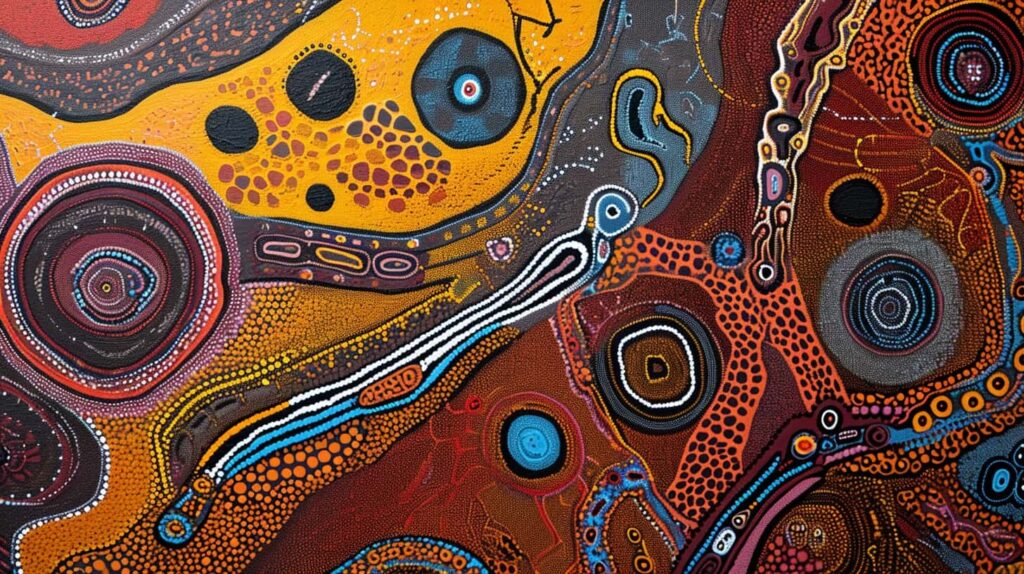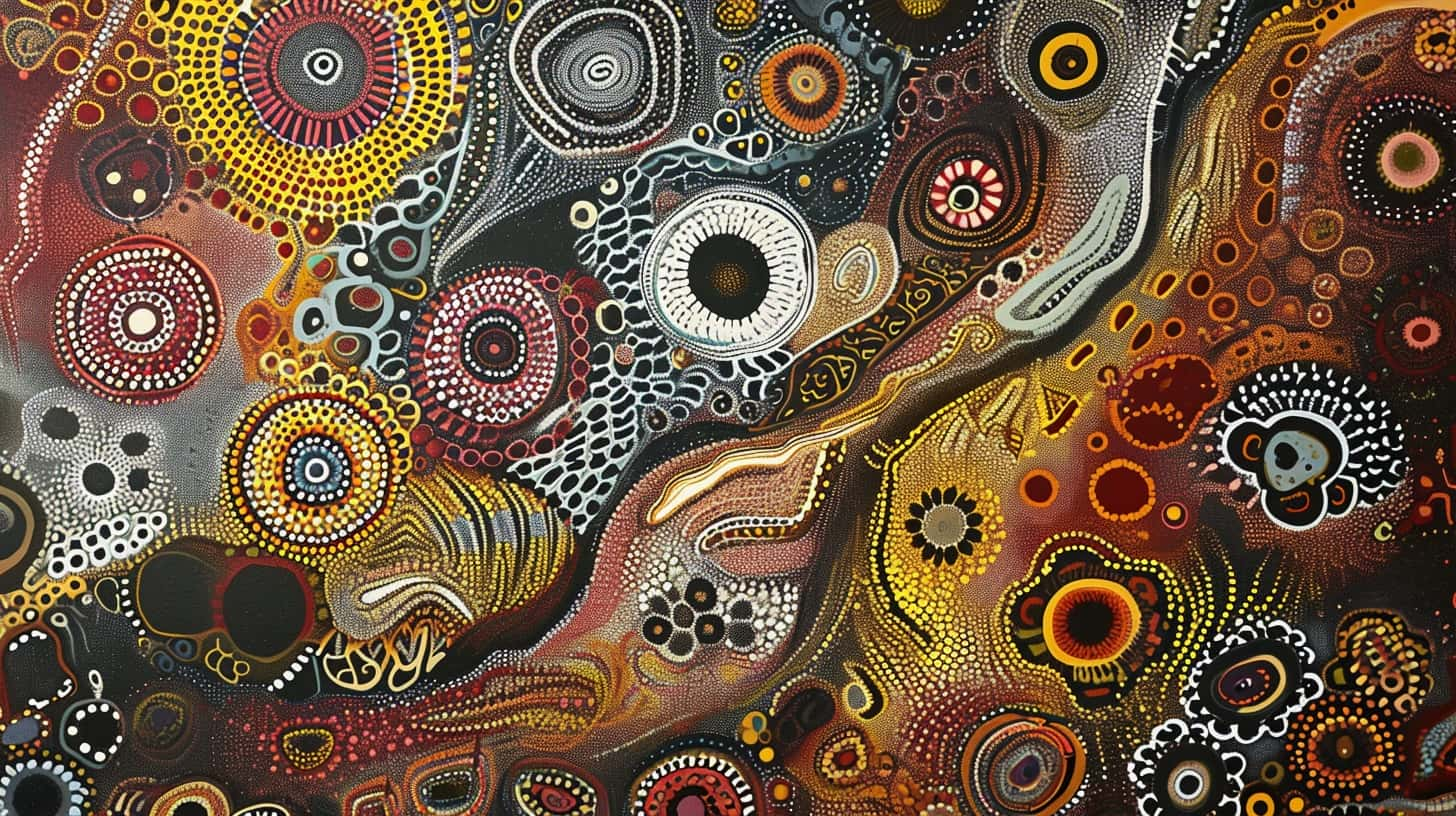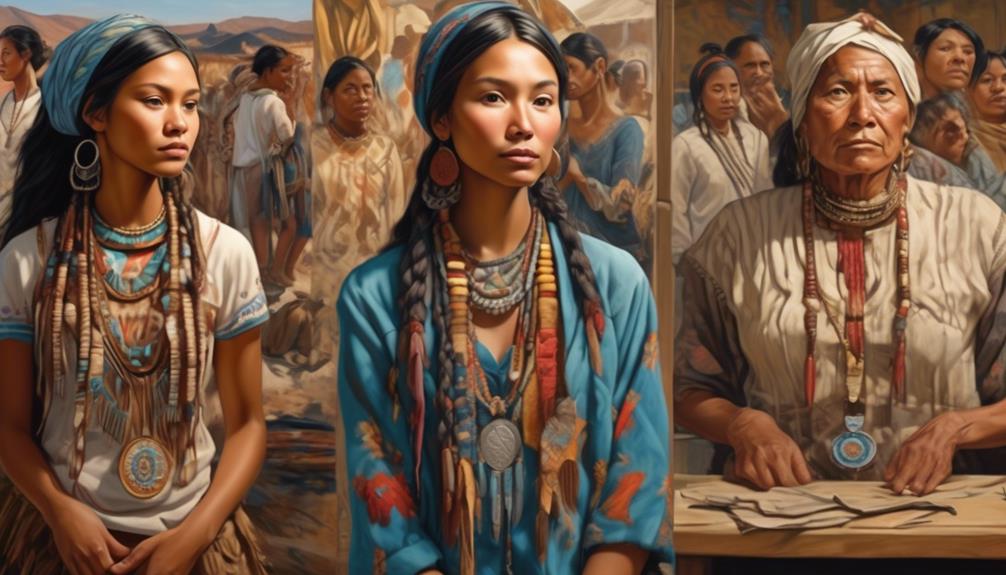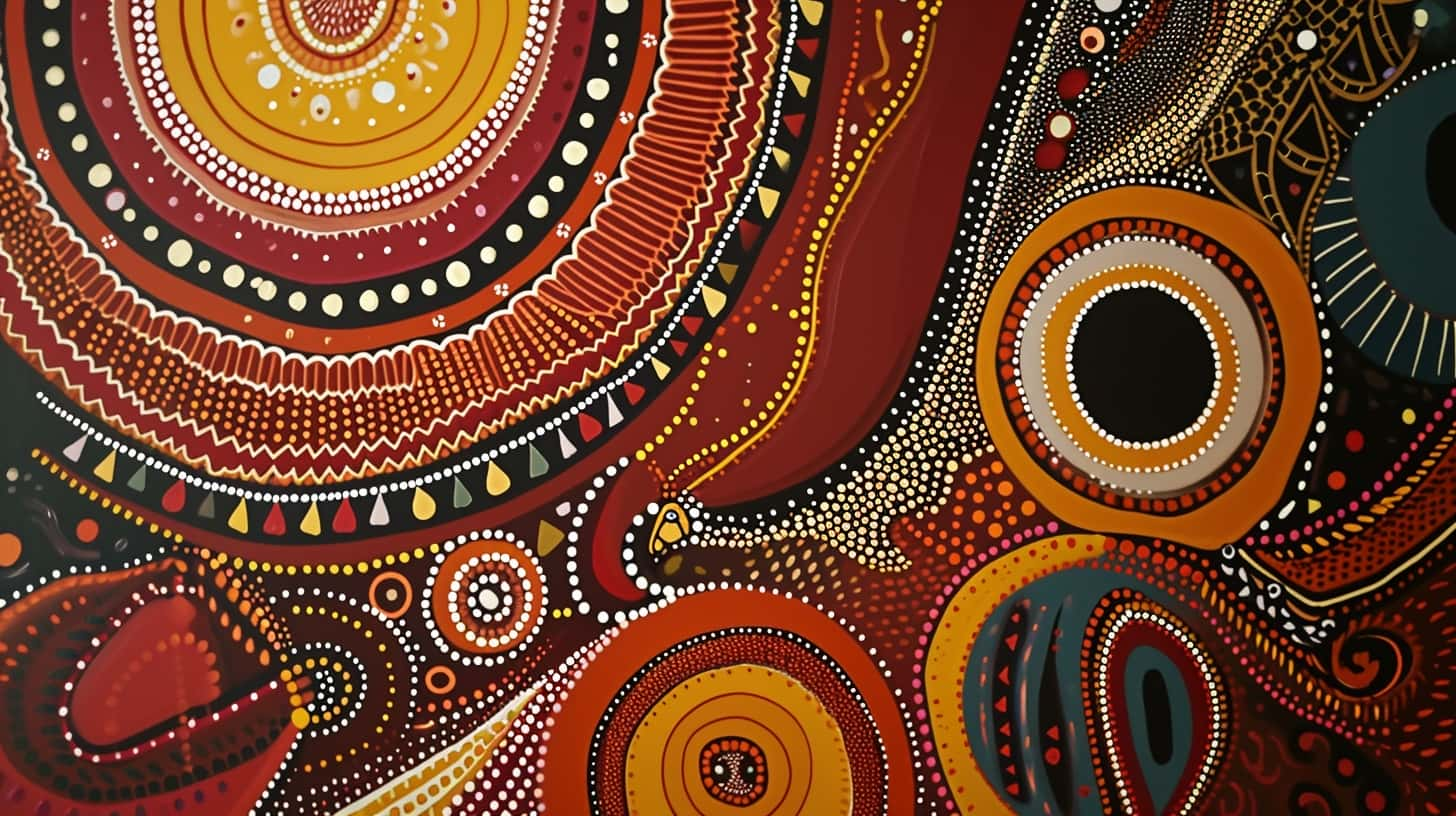We are beginning a journey to explore the captivating world of Aboriginal art, a tradition steeped in history and cultural heritage. Indigenous Australians have been using this vibrant and expressive art form for thousands of years. Now, it is time for our KS1 class to join us on this adventure, to discover the beauty and cultural significance found in Aboriginal art.
By introducing our young learners to this art form, we aim to foster an appreciation for diverse cultures while igniting their creativity through engaging activities and lessons. Embracing Aboriginal art at such a formative age not only enriches our students’ understanding of different traditions but also encourages them to express themselves artistically.
Delving into Australian Aboriginal Art History
Ancient Origins
Australian Aboriginal art has a rich and ancient history, spanning over 40,000 years. This makes it one of the oldest continuous artistic traditions in the world. The deep roots of this art form are intertwined with Indigenous culture and spirituality, providing a unique insight into the beliefs and traditions of Australia’s first peoples.
Exploring the history of Aboriginal art can be an eye-opening experience for KS1 students. It allows them to understand how these artworks are not merely decorative pieces but serve as a means of storytelling, passing down knowledge from generation to generation. For example, they might learn about how certain symbols or patterns represent specific Dreamtime stories or depict significant events in Indigenous history.

Evolution and Adaptation
As we delve deeper into the evolution of Australian Aboriginal art, we discover its remarkable adaptability over time. From rock paintings to intricate dot paintings on canvas, this art form has evolved while still maintaining its cultural significance. The introduction of new materials such as acrylic paints and canvases has allowed artists to expand their creative expressions while staying true to traditional themes.
Learning about this evolution provides valuable insights into how artistic practices have adapted within Indigenous communities while preserving their cultural heritage. For instance, students may learn about contemporary Aboriginal artists who continue to create stunning works inspired by ancestral stories but with modern influences.
Connection to Culture
Studying the origins and development of Australian Aboriginal art offers KS1 students a profound understanding of its connection to culture and spirituality. They can gain an appreciation for how these artworks are deeply rooted in rituals, ceremonies, and everyday life within Indigenous communities.
Understanding Aboriginal Art Symbols and Their Meanings
Decoding Symbols
When we look at Aboriginal art, we see a beautiful array of symbols that hold deep meanings. These symbols are not just random designs; they represent the stories, traditions, and beliefs of Indigenous communities. By teaching KS1 students about these symbols, we can help them appreciate the cultural significance behind each artwork. For example, the “U” shapes often depict people sitting around a campfire or waterhole in traditional Aboriginal life.
Understanding these symbols allows us to gain insight into the rich history and heritage of Australia’s First Nations peoples. The use of circles might represent meeting places or significant locations within their environment. By decoding these symbols, young learners can develop empathy and understanding for cultures different from their own.
Cultural Significance
Teaching KS1 students about Aboriginal art symbols goes beyond recognizing patterns; it provides an opportunity to foster respect for diverse cultures. When kids learn about the meaning behind each symbol, they become more aware of the world around them and understand that there are various ways to express ideas and stories through art.
By delving into these intricate details, children also cultivate critical thinking skills as they analyze and interpret visual information. They begin to realize that every stroke in an Aboriginal painting tells a unique story—a story deeply rooted in tradition and spirituality.
Connecting with Stories
As educators introduce Aboriginal art to KS1 students, they open doors to captivating tales passed down through generations. Each symbol is like a word in a book—one piece of a larger narrative waiting to be discovered by eager young minds.

For instance, the “W” shapes commonly found in artworks may signify tracks left by animals or humans moving across landscapes or hunting grounds—stories embedded within nature itself! This connection between art and storytelling helps children grasp how visual representations can carry historical narratives from one generation to another.
Exploring Patterns and Dots in Aboriginal Artwork
Understanding Techniques
In Aboriginal art, we often see intricate patterns and meticulous arrangements of dots. These features add depth, visual interest, and cultural significance to the artwork. When creating our own pieces inspired by Aboriginal art, it’s essential for us to explore these techniques. By understanding how patterns and dots are used in this art form, we can appreciate the skill and effort that go into each piece.
When looking at Aboriginal artworks with patterns and dots, we notice the careful placement of each element. The artists use a wide range of colors to create striking designs that tell stories or represent their connection to nature. As KS1 students exploring this style of art, we can experiment with different color combinations while learning about traditional meanings behind specific colors.
Creating Unique Designs
As young artists inspired by Aboriginal art, we have the opportunity to create our own unique designs using patterns and dots. We can start by observing various examples of Aboriginal artworks featuring different types of patterns – from concentric circles representing waterholes or campsites to straight lines symbolizing travel paths or borders between territories.
By studying these diverse patterns used in Aboriginal art, we gain insight into their cultural significance while also honing our artistic skills. We might choose to incorporate elements such as meandering lines denoting rivers or wavy lines signifying sand dunes into our own creations.
Enhancing Appreciation
Understanding the purpose behind patterns and dots in Aboriginal art enhances our appreciation for the meticulous craftsmanship involved in producing such visually stunning pieces. Through this exploration process, not only do we learn about a rich cultural tradition but also develop an eye for detail as budding artists ourselves.
We come to realize that every dot meticulously placed on an artwork represents more than just a decorative element; it symbolizes stories passed down through generations or connections to ancestral lands. This newfound awareness deepens our respect for Indigenous cultures while inspiring us to approach our own creative endeavors with thoughtfulness and intentionality.
Significance of Animals in Aboriginal Art and Dreamtime Stories
Ancestral Connections
Animals play a significant role in Aboriginal art as they symbolize ancestral connections. These animals are often depicted in artwork to represent the relationship between Indigenous people and the land. For instance, the kangaroo is a prominent figure in many Aboriginal artworks, symbolizing strength, agility, and survival skills. By understanding these representations, KS1 students can grasp the deep connection between the Indigenous communities and nature.
In some cases, animals featured in Aboriginal art also serve as totems for specific clans or groups within Indigenous communities. This concept can be likened to having a family crest or emblem that represents one’s lineage or heritage. Exploring this aspect of Aboriginal art allows young learners to appreciate how different cultures express their identity through symbols and imagery.
Spiritual Beliefs
Beyond their physical representation, animals hold spiritual significance in Aboriginal culture, often embodying sacred qualities within Dreamtime stories. For example, the story of Tiddalik illustrates how an enormous frog drank all the water on Earth until other animals worked together to make him laugh and release the water back into rivers and lakes. Such narratives not only entertain but also convey important moral lessons about cooperation and respect for nature.
Teaching KS1 students about these Dreamtime stories associated with animals provides them with valuable insights into Indigenous mythology while fostering empathy towards diverse belief systems. It encourages them to recognize that different cultures have unique ways of explaining natural phenomena through storytelling traditions.
Cultural Empathy
By delving into Dreamtime stories linked with various animals depicted in Aboriginal art, we enable KS1 students to develop cultural empathy by appreciating alternative perspectives on creation, existence, morality, and spirituality. This exposure broadens their worldview beyond their immediate surroundings by introducing them to rich cultural heritages that differ from their own.
Understanding these aspects not only enriches students’ knowledge but also cultivates respect for diversity at an early age. It lays a foundation for embracing multiculturalism while nurturing an inclusive mindset toward people from various backgrounds.
Creative Storytelling with Aboriginal Art Animal Symbols
Understanding Symbolism
When creating Aboriginal art for KS1, it’s essential to understand the symbolism behind each animal. For instance, the kangaroo represents agility and strength in Indigenous culture. By incorporating these symbols into our artwork, we can convey specific traits or characteristics within our stories. This helps us connect with nature and learn about the significance of animals in Dreamtime stories.
Using natural materials such as ochre and charcoal allows us to embrace traditional Aboriginal art techniques. We can depict various animals like kangaroos, emus, or snakes using these materials to tell captivating stories through our drawings.
Promoting Imagination and Critical Thinking
Incorporating Aboriginal art animal symbols into storytelling encourages us to think critically about the traits associated with each animal. For example, when drawing a kangaroo, we might consider how its speed and agility could play a role in our story. This process fosters imagination and critical thinking skills as we weave narratives around these symbolic representations.
Teaching Aboriginal Art Techniques to Children
Exploring Different Mediums
When teaching aboriginal art techniques to KS1 students, we open up a world of creativity and expression. By introducing them to various mediums such as painting, dotting, and carving, we allow them to explore different ways of creating art. This not only sparks their imagination but also helps them understand the versatility of artistic expression.
Art is a powerful form of communication that transcends language barriers. Through aboriginal art techniques, children can convey stories, emotions, and experiences in unique ways. For instance, after learning about animal symbols in the previous section, they can use these symbols in their artwork to tell imaginative stories or express feelings.
Developing Fine Motor Skills
Teaching techniques like cross-hatching (creating patterns with intersecting lines), stippling (using dots to create images), and blending (mixing colors seamlessly) not only enhances students’ artistic abilities but also aids in the development of their fine motor skills. As they meticulously apply these techniques on canvas or paper, they improve their hand-eye coordination and precision.
Engaging in activities that require attention to detail strengthens children’s focus and patience. For example, when guiding them through the process of stippling an animal symbol onto a piece of art using cotton swabs or fingers dipped in paint, they learn how small actions contribute to a larger picture.
Cultivating Cultural Appreciation
By exposing young learners to traditional art techniques practiced by Aboriginal communities for generations, we instill within them a deep sense of cultural appreciation and respect for Indigenous practices. They gain insight into the rich history behind each technique and its significance within Aboriginal culture.
Understanding the origins of these techniques allows children to appreciate diversity and recognize the value of different cultural traditions. It fosters empathy as they realize that people from various backgrounds have unique ways of expressing themselves through art.
Incorporating Boomerang and Hand Stencil Designs in Art Projects
Exploring Indigenous Symbolism
When creating artworks inspired by Aboriginal culture, incorporating boomerang and hand stencil designs can be a fascinating journey for us. These iconic elements of Aboriginal art hold deep cultural significance and symbolism. By introducing these symbols to KS1 students, we not only encourage them to explore their creativity but also provide an opportunity for them to learn about Indigenous traditions. This exploration allows children to appreciate the rich cultural heritage of Australia’s First Nations people while creating their own unique pieces of art.
Embracing boomerang and hand stencil designs in our art projects opens up a world of learning about the history, meaning, and importance behind these symbols. For instance, when we guide children through creating drawings or artworks featuring these designs, we can share stories about how boomerangs were traditionally used for hunting or the significance of hand stencils in Indigenous ceremonies. This engagement not only enriches their understanding but also fosters respect for diverse cultures.
Differentiated Activity Ideas
Incorporating boomerang and hand stencil designs into our art projects offers an array of differentiated activity ideas suitable for KS1 students with varying skill levels. For example,
- We can introduce simple clay modeling activities where children mold mini-boomerangs using soft clay.
- Providing printable resources with outlines of boomerangs and hand stencils allows students to engage in coloring activities that align with their motor skills development.
By offering such varied activities, we cater to different learning styles while ensuring that all students have the opportunity to participate meaningfully in exploring Aboriginal art forms.
Promoting Cultural Appreciation
Integrating these symbolic designs into our art projects goes beyond mere artistic expression; it promotes cultural appreciation among young learners. As they immerse themselves in creating artworks inspired by traditional Aboriginal elements, they develop a sense of respect towards diverse cultures.
Moreover, as educators or mentors guiding this creative process, it’s crucial for us to emphasize the value placed on these symbols within Indigenous communities. Through this approach, we instill empathy and understanding among children regarding the importance of respecting cultural heritage.
The Role of Dot Painting and X-Ray Art in Aboriginal Culture
Ancestral Connections
Dot painting is a significant technique in Aboriginal art, symbolizing the deep-rooted connections to ancestral lands and sacred sites. Each dot represents an aspect of the land, such as waterholes, plants, or ceremonial grounds. When we look at these paintings, we see more than just colorful dots; we see a spiritual map that tells stories of creation and connection to the land.
The process of creating dot paintings involves meticulousness and patience. Artists use fine brushes or even sticks to carefully place each dot on the canvas. This method not only reflects the reverence for their cultural heritage but also teaches us about mindfulness and attention to detail. For KS1 students, understanding this significance can foster respect for diverse traditions while nurturing their own creativity through mindful art practices.
Spiritual Essence
In contrast to dot painting, X-Ray art offers a unique glimpse into Aboriginal spirituality by revealing the inner essence of living creatures. This style portrays animals with their internal organs or skeletal structures visible—depicting not just what’s seen on the surface but also what lies beneath.
When discussing X-Ray art with KS1 students, we can draw parallels between this artistic representation and storytelling. Just like how books hold captivating narratives within their covers, X-Ray art showcases that there’s always more than meets the eye. Through this comparison, children can appreciate how different cultures express stories and beliefs through various mediums—be it written words or intricate artworks.
Deepening Appreciation
By delving into dot painting and X-Ray art, KS1 students gain insight into Indigenous Australian culture beyond mere aesthetics—they learn about values deeply embedded in these traditions: respect for nature, acknowledgment of ancestors’ wisdom, and recognition of spiritual interconnectedness.
Understanding these aspects fosters empathy towards diverse cultures from an early age while encouraging open-mindedness toward unconventional artistic expressions beyond what they may be familiar with in their own communities.
- Dot painting represents ancestral connections & sacred sites.
- It teaches mindfulness & attention to detail.
- X-Ray art reveals inner essence within living creatures.
- It parallels storytelling & expressing beliefs through different mediums.
- Understanding fosters empathy towards diverse cultures from an early age.
Inspiring KS1 Students to Create Their Own Aboriginal Art Narratives
Expressing Narratives
Encouraging KS1 students to create their own Aboriginal-inspired artworks allows them to express their unique narratives. Through vibrant colors, symbolic patterns, and storytelling elements, young learners can convey their thoughts, experiences, and emotions. For instance, they might depict the animals they love or the adventures they dream of having.
Creating art provides a platform for children to communicate in ways that words cannot fully capture. It enables them to share personal stories or imaginative tales through visual representation. This process not only enhances their artistic skills but also empowers them to express themselves freely without constraints.
Fostering Confidence
By providing opportunities for self-expression through art, we help KS1 students build confidence in their creative abilities. When children see their ideas come alive on paper or canvas, it boosts their self-esteem and encourages them to explore new possibilities. For example, when a child successfully creates an Aboriginal-inspired artwork based on his or her own narrative, it instills a sense of pride and accomplishment.
Engaging in art activities also allows children to experiment with different techniques and materials while discovering what works best for them. This exploration fosters a growth mindset by teaching kids that making mistakes is part of the learning process and that there are multiple ways to approach artistic expression.
Embracing Cultural Understanding
Through creating Aboriginal art narratives, students develop a deeper connection with Indigenous culture while embracing their own creativity. By learning about traditional Aboriginal symbols such as waterholes, campfires, or animal tracks during this process of creation helps foster cultural understanding among young learners.
As they immerse themselves in the world of Aboriginal artistry through hands-on experience rather than just reading about it in books or watching videos; this active engagement deepens not only cultural appreciation but also empathy towards diverse traditions and perspectives.
Conclusion
We’ve journeyed through the rich tapestry of Australian Aboriginal art, uncovering its deep-rooted history, symbolism, and techniques. Embracing the stories of Dreamtime, we’ve delved into the significance of animals and learned how to infuse our narratives with creativity. We’ve explored the intricate patterns and dots, discovering their cultural significance and mastering the art of storytelling through visuals. Our adventure has led us to understand the essence of dot painting and X-ray art, immersing ourselves in the vibrant culture of Aboriginal communities.
As we conclude this artistic escapade, let’s carry forward our newfound knowledge and passion. Let’s inspire our young learners to embrace diversity, creativity, and storytelling through their own Aboriginal art projects. Let’s continue to celebrate and honor Indigenous cultures, fostering a deep appreciation for their traditions. Together, we can ensure that the legacy of Aboriginal art continues to inspire and educate generations to come.
Frequently Asked Questions
What is the significance of animals in Aboriginal art?
Animals hold great importance in Aboriginal art as they are often used to convey Dreamtime stories and cultural beliefs. Each animal symbolizes specific qualities and characteristics, enriching the narratives depicted in the artwork.
How can I teach Aboriginal art techniques to KS1 students effectively?
Teach basic techniques such as dot painting, hand stencils, and storytelling through symbols. Encourage creativity while respecting the cultural significance of these techniques. Incorporate hands-on activities and discussions about the meanings behind different symbols.
Why are patterns and dots commonly used in Aboriginal artwork?
Patterns and dots are integral to conveying stories, representing natural elements like waterholes or sand dunes. They also serve a practical purpose by providing camouflage during hunting expeditions.
What is the role of X-Ray art in Aboriginal culture?
X-Ray art depicts internal anatomy or bone structures of animals, reflecting a spiritual connection between humans and nature. It serves as a visual representation of ancestral knowledge passed down through generations.
How can I inspire KS1 students to create their own Aboriginal art narratives?
Encourage students to explore their imagination by integrating personal experiences with themes from Dreamtime stories. Emphasize storytelling through symbols representing nature, animals, or significant events within their lives.









